Accounting Theory and Accountability: Linking Bonuses to Performance
VerifiedAdded on 2023/04/05
|14
|3152
|300
Report
AI Summary
This report delves into the critical aspects of accounting theory and accountability, particularly focusing on the implementation of environmental and social performance measures to be tied with executive bonuses. The report provides an analysis of performance indicators related to environmental issues such as Greenhouse Gas emissions, waste reduction, energy usage, and product development with minimized environmental impact. Furthermore, it examines performance measures associated with social issues, including employee injury rates, employee engagement, strategic community investments, stakeholder management, and consumer complaints. Highlighting the significance of sustainability reporting and triple bottom line (TBL) reporting, the report underscores how these measures provide companies with opportunities to communicate their strategies and progress to stakeholders. The report concludes that integrating environmental sustainability and social issues into performance measures, directly linked to executive incentives, creates an obligation for companies to consider these issues, benefiting both the companies and society by fostering shared value creation.

Running head: ACCOUNTING THEORY AND ACCOUNTABILITY
Accounting Theory and Accountability
Name of the Student
Name of the University
Author’s Note
Accounting Theory and Accountability
Name of the Student
Name of the University
Author’s Note
Paraphrase This Document
Need a fresh take? Get an instant paraphrase of this document with our AI Paraphraser
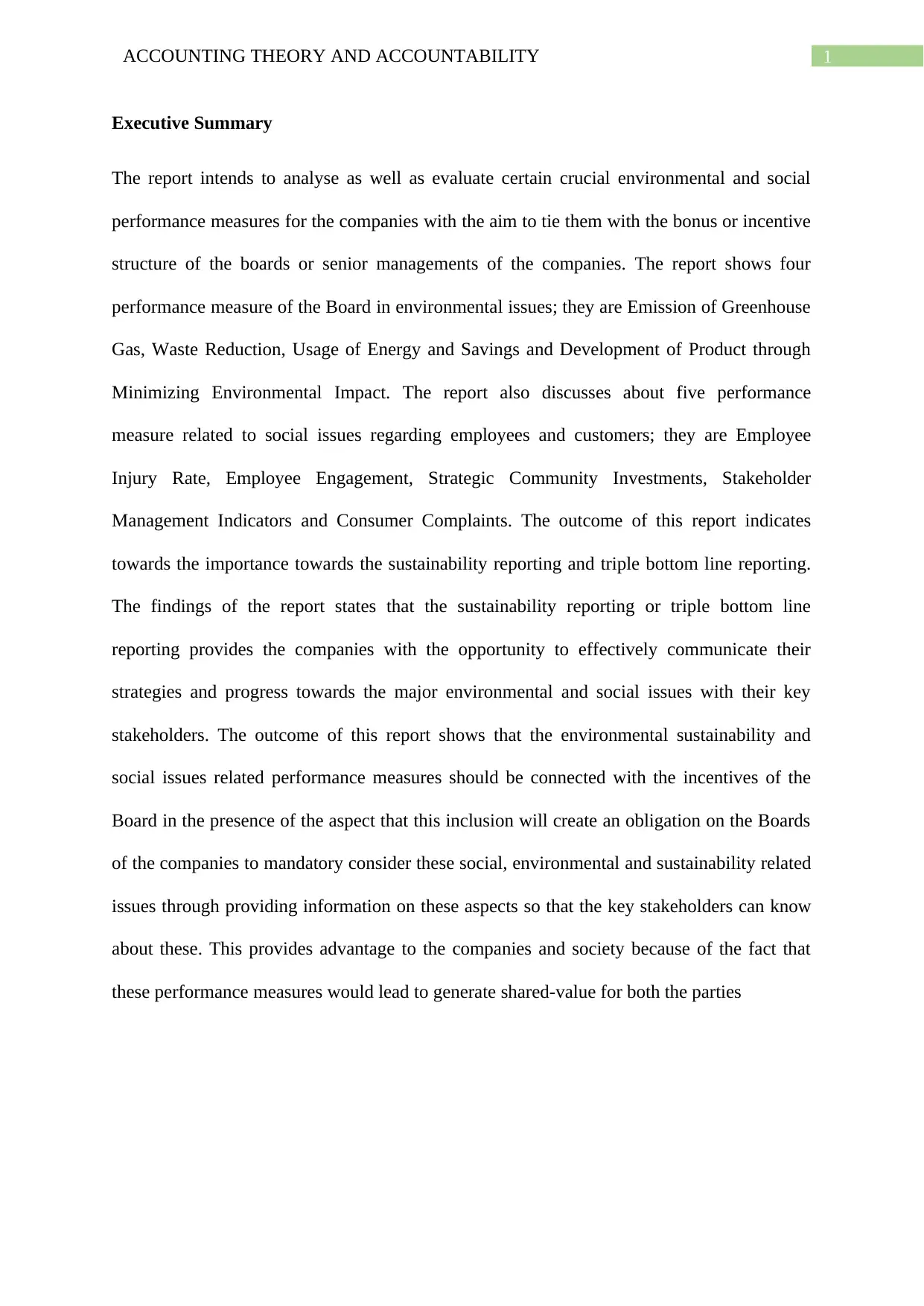
1ACCOUNTING THEORY AND ACCOUNTABILITY
Executive Summary
The report intends to analyse as well as evaluate certain crucial environmental and social
performance measures for the companies with the aim to tie them with the bonus or incentive
structure of the boards or senior managements of the companies. The report shows four
performance measure of the Board in environmental issues; they are Emission of Greenhouse
Gas, Waste Reduction, Usage of Energy and Savings and Development of Product through
Minimizing Environmental Impact. The report also discusses about five performance
measure related to social issues regarding employees and customers; they are Employee
Injury Rate, Employee Engagement, Strategic Community Investments, Stakeholder
Management Indicators and Consumer Complaints. The outcome of this report indicates
towards the importance towards the sustainability reporting and triple bottom line reporting.
The findings of the report states that the sustainability reporting or triple bottom line
reporting provides the companies with the opportunity to effectively communicate their
strategies and progress towards the major environmental and social issues with their key
stakeholders. The outcome of this report shows that the environmental sustainability and
social issues related performance measures should be connected with the incentives of the
Board in the presence of the aspect that this inclusion will create an obligation on the Boards
of the companies to mandatory consider these social, environmental and sustainability related
issues through providing information on these aspects so that the key stakeholders can know
about these. This provides advantage to the companies and society because of the fact that
these performance measures would lead to generate shared-value for both the parties
Executive Summary
The report intends to analyse as well as evaluate certain crucial environmental and social
performance measures for the companies with the aim to tie them with the bonus or incentive
structure of the boards or senior managements of the companies. The report shows four
performance measure of the Board in environmental issues; they are Emission of Greenhouse
Gas, Waste Reduction, Usage of Energy and Savings and Development of Product through
Minimizing Environmental Impact. The report also discusses about five performance
measure related to social issues regarding employees and customers; they are Employee
Injury Rate, Employee Engagement, Strategic Community Investments, Stakeholder
Management Indicators and Consumer Complaints. The outcome of this report indicates
towards the importance towards the sustainability reporting and triple bottom line reporting.
The findings of the report states that the sustainability reporting or triple bottom line
reporting provides the companies with the opportunity to effectively communicate their
strategies and progress towards the major environmental and social issues with their key
stakeholders. The outcome of this report shows that the environmental sustainability and
social issues related performance measures should be connected with the incentives of the
Board in the presence of the aspect that this inclusion will create an obligation on the Boards
of the companies to mandatory consider these social, environmental and sustainability related
issues through providing information on these aspects so that the key stakeholders can know
about these. This provides advantage to the companies and society because of the fact that
these performance measures would lead to generate shared-value for both the parties
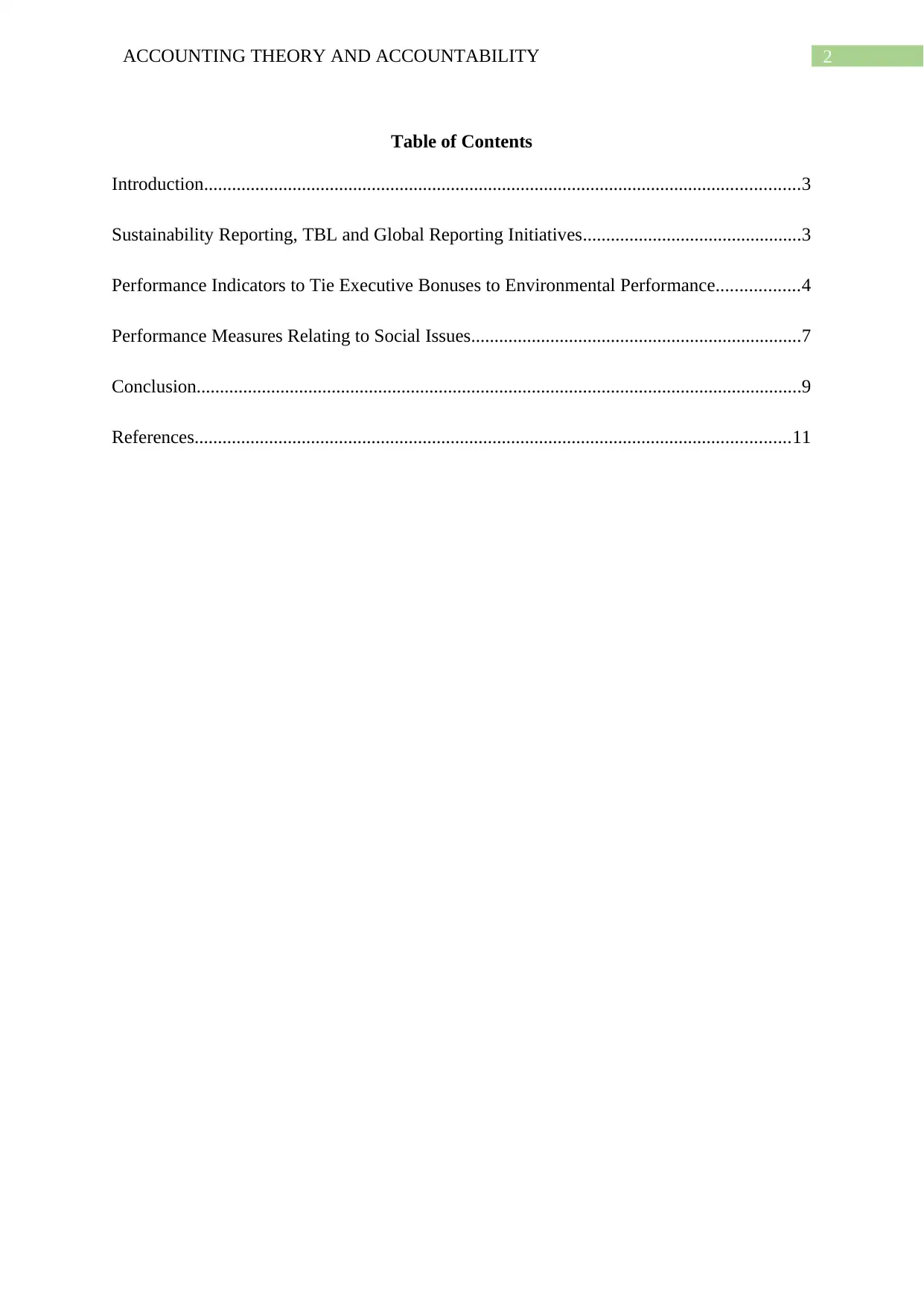
2ACCOUNTING THEORY AND ACCOUNTABILITY
Table of Contents
Introduction................................................................................................................................3
Sustainability Reporting, TBL and Global Reporting Initiatives...............................................3
Performance Indicators to Tie Executive Bonuses to Environmental Performance..................4
Performance Measures Relating to Social Issues.......................................................................7
Conclusion..................................................................................................................................9
References................................................................................................................................11
Table of Contents
Introduction................................................................................................................................3
Sustainability Reporting, TBL and Global Reporting Initiatives...............................................3
Performance Indicators to Tie Executive Bonuses to Environmental Performance..................4
Performance Measures Relating to Social Issues.......................................................................7
Conclusion..................................................................................................................................9
References................................................................................................................................11
⊘ This is a preview!⊘
Do you want full access?
Subscribe today to unlock all pages.

Trusted by 1+ million students worldwide
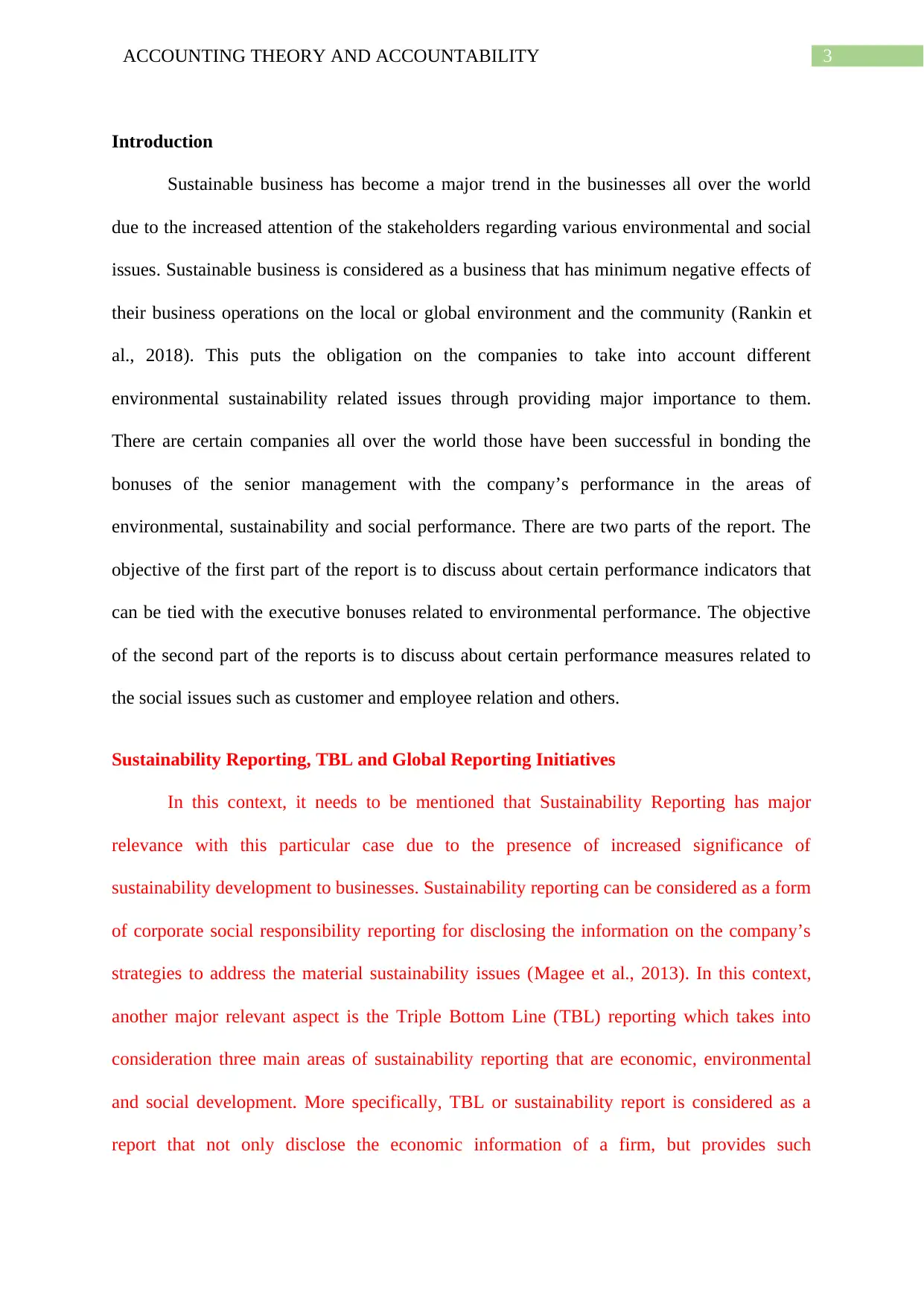
3ACCOUNTING THEORY AND ACCOUNTABILITY
Introduction
Sustainable business has become a major trend in the businesses all over the world
due to the increased attention of the stakeholders regarding various environmental and social
issues. Sustainable business is considered as a business that has minimum negative effects of
their business operations on the local or global environment and the community (Rankin et
al., 2018). This puts the obligation on the companies to take into account different
environmental sustainability related issues through providing major importance to them.
There are certain companies all over the world those have been successful in bonding the
bonuses of the senior management with the company’s performance in the areas of
environmental, sustainability and social performance. There are two parts of the report. The
objective of the first part of the report is to discuss about certain performance indicators that
can be tied with the executive bonuses related to environmental performance. The objective
of the second part of the reports is to discuss about certain performance measures related to
the social issues such as customer and employee relation and others.
Sustainability Reporting, TBL and Global Reporting Initiatives
In this context, it needs to be mentioned that Sustainability Reporting has major
relevance with this particular case due to the presence of increased significance of
sustainability development to businesses. Sustainability reporting can be considered as a form
of corporate social responsibility reporting for disclosing the information on the company’s
strategies to address the material sustainability issues (Magee et al., 2013). In this context,
another major relevant aspect is the Triple Bottom Line (TBL) reporting which takes into
consideration three main areas of sustainability reporting that are economic, environmental
and social development. More specifically, TBL or sustainability report is considered as a
report that not only disclose the economic information of a firm, but provides such
Introduction
Sustainable business has become a major trend in the businesses all over the world
due to the increased attention of the stakeholders regarding various environmental and social
issues. Sustainable business is considered as a business that has minimum negative effects of
their business operations on the local or global environment and the community (Rankin et
al., 2018). This puts the obligation on the companies to take into account different
environmental sustainability related issues through providing major importance to them.
There are certain companies all over the world those have been successful in bonding the
bonuses of the senior management with the company’s performance in the areas of
environmental, sustainability and social performance. There are two parts of the report. The
objective of the first part of the report is to discuss about certain performance indicators that
can be tied with the executive bonuses related to environmental performance. The objective
of the second part of the reports is to discuss about certain performance measures related to
the social issues such as customer and employee relation and others.
Sustainability Reporting, TBL and Global Reporting Initiatives
In this context, it needs to be mentioned that Sustainability Reporting has major
relevance with this particular case due to the presence of increased significance of
sustainability development to businesses. Sustainability reporting can be considered as a form
of corporate social responsibility reporting for disclosing the information on the company’s
strategies to address the material sustainability issues (Magee et al., 2013). In this context,
another major relevant aspect is the Triple Bottom Line (TBL) reporting which takes into
consideration three main areas of sustainability reporting that are economic, environmental
and social development. More specifically, TBL or sustainability report is considered as a
report that not only disclose the economic information of a firm, but provides such
Paraphrase This Document
Need a fresh take? Get an instant paraphrase of this document with our AI Paraphraser
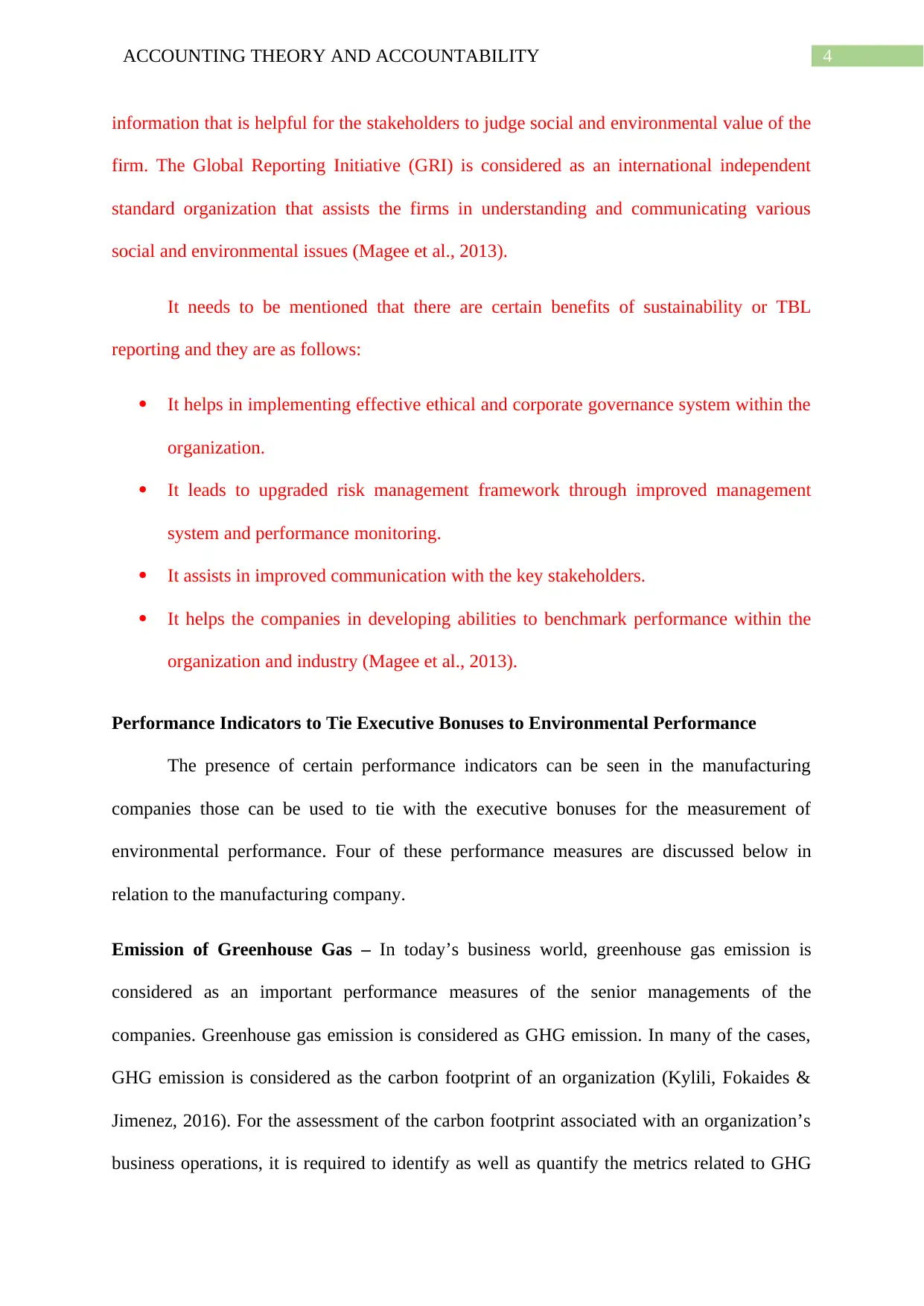
4ACCOUNTING THEORY AND ACCOUNTABILITY
information that is helpful for the stakeholders to judge social and environmental value of the
firm. The Global Reporting Initiative (GRI) is considered as an international independent
standard organization that assists the firms in understanding and communicating various
social and environmental issues (Magee et al., 2013).
It needs to be mentioned that there are certain benefits of sustainability or TBL
reporting and they are as follows:
It helps in implementing effective ethical and corporate governance system within the
organization.
It leads to upgraded risk management framework through improved management
system and performance monitoring.
It assists in improved communication with the key stakeholders.
It helps the companies in developing abilities to benchmark performance within the
organization and industry (Magee et al., 2013).
Performance Indicators to Tie Executive Bonuses to Environmental Performance
The presence of certain performance indicators can be seen in the manufacturing
companies those can be used to tie with the executive bonuses for the measurement of
environmental performance. Four of these performance measures are discussed below in
relation to the manufacturing company.
Emission of Greenhouse Gas – In today’s business world, greenhouse gas emission is
considered as an important performance measures of the senior managements of the
companies. Greenhouse gas emission is considered as GHG emission. In many of the cases,
GHG emission is considered as the carbon footprint of an organization (Kylili, Fokaides &
Jimenez, 2016). For the assessment of the carbon footprint associated with an organization’s
business operations, it is required to identify as well as quantify the metrics related to GHG
information that is helpful for the stakeholders to judge social and environmental value of the
firm. The Global Reporting Initiative (GRI) is considered as an international independent
standard organization that assists the firms in understanding and communicating various
social and environmental issues (Magee et al., 2013).
It needs to be mentioned that there are certain benefits of sustainability or TBL
reporting and they are as follows:
It helps in implementing effective ethical and corporate governance system within the
organization.
It leads to upgraded risk management framework through improved management
system and performance monitoring.
It assists in improved communication with the key stakeholders.
It helps the companies in developing abilities to benchmark performance within the
organization and industry (Magee et al., 2013).
Performance Indicators to Tie Executive Bonuses to Environmental Performance
The presence of certain performance indicators can be seen in the manufacturing
companies those can be used to tie with the executive bonuses for the measurement of
environmental performance. Four of these performance measures are discussed below in
relation to the manufacturing company.
Emission of Greenhouse Gas – In today’s business world, greenhouse gas emission is
considered as an important performance measures of the senior managements of the
companies. Greenhouse gas emission is considered as GHG emission. In many of the cases,
GHG emission is considered as the carbon footprint of an organization (Kylili, Fokaides &
Jimenez, 2016). For the assessment of the carbon footprint associated with an organization’s
business operations, it is required to identify as well as quantify the metrics related to GHG
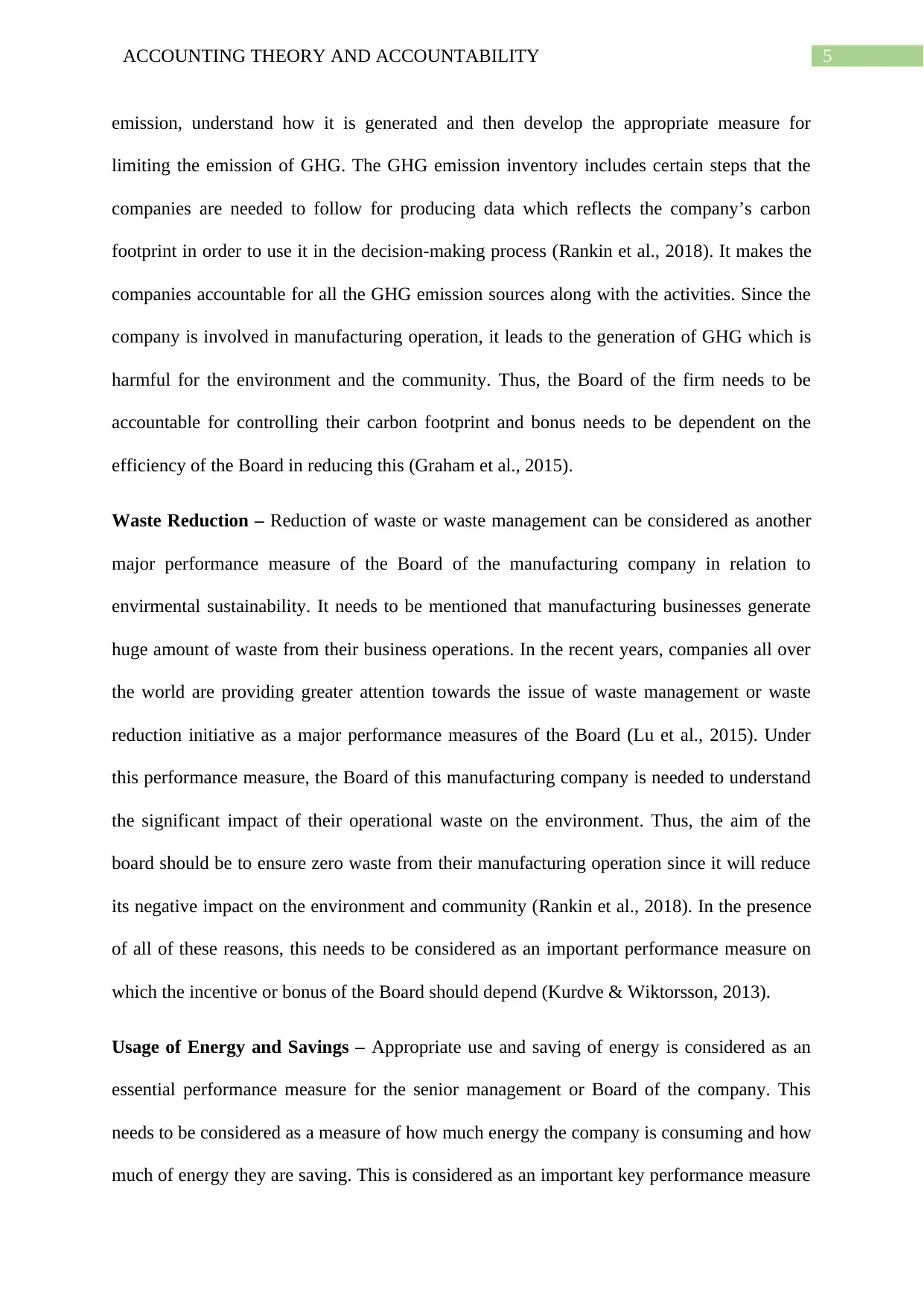
5ACCOUNTING THEORY AND ACCOUNTABILITY
emission, understand how it is generated and then develop the appropriate measure for
limiting the emission of GHG. The GHG emission inventory includes certain steps that the
companies are needed to follow for producing data which reflects the company’s carbon
footprint in order to use it in the decision-making process (Rankin et al., 2018). It makes the
companies accountable for all the GHG emission sources along with the activities. Since the
company is involved in manufacturing operation, it leads to the generation of GHG which is
harmful for the environment and the community. Thus, the Board of the firm needs to be
accountable for controlling their carbon footprint and bonus needs to be dependent on the
efficiency of the Board in reducing this (Graham et al., 2015).
Waste Reduction – Reduction of waste or waste management can be considered as another
major performance measure of the Board of the manufacturing company in relation to
envirmental sustainability. It needs to be mentioned that manufacturing businesses generate
huge amount of waste from their business operations. In the recent years, companies all over
the world are providing greater attention towards the issue of waste management or waste
reduction initiative as a major performance measures of the Board (Lu et al., 2015). Under
this performance measure, the Board of this manufacturing company is needed to understand
the significant impact of their operational waste on the environment. Thus, the aim of the
board should be to ensure zero waste from their manufacturing operation since it will reduce
its negative impact on the environment and community (Rankin et al., 2018). In the presence
of all of these reasons, this needs to be considered as an important performance measure on
which the incentive or bonus of the Board should depend (Kurdve & Wiktorsson, 2013).
Usage of Energy and Savings – Appropriate use and saving of energy is considered as an
essential performance measure for the senior management or Board of the company. This
needs to be considered as a measure of how much energy the company is consuming and how
much of energy they are saving. This is considered as an important key performance measure
emission, understand how it is generated and then develop the appropriate measure for
limiting the emission of GHG. The GHG emission inventory includes certain steps that the
companies are needed to follow for producing data which reflects the company’s carbon
footprint in order to use it in the decision-making process (Rankin et al., 2018). It makes the
companies accountable for all the GHG emission sources along with the activities. Since the
company is involved in manufacturing operation, it leads to the generation of GHG which is
harmful for the environment and the community. Thus, the Board of the firm needs to be
accountable for controlling their carbon footprint and bonus needs to be dependent on the
efficiency of the Board in reducing this (Graham et al., 2015).
Waste Reduction – Reduction of waste or waste management can be considered as another
major performance measure of the Board of the manufacturing company in relation to
envirmental sustainability. It needs to be mentioned that manufacturing businesses generate
huge amount of waste from their business operations. In the recent years, companies all over
the world are providing greater attention towards the issue of waste management or waste
reduction initiative as a major performance measures of the Board (Lu et al., 2015). Under
this performance measure, the Board of this manufacturing company is needed to understand
the significant impact of their operational waste on the environment. Thus, the aim of the
board should be to ensure zero waste from their manufacturing operation since it will reduce
its negative impact on the environment and community (Rankin et al., 2018). In the presence
of all of these reasons, this needs to be considered as an important performance measure on
which the incentive or bonus of the Board should depend (Kurdve & Wiktorsson, 2013).
Usage of Energy and Savings – Appropriate use and saving of energy is considered as an
essential performance measure for the senior management or Board of the company. This
needs to be considered as a measure of how much energy the company is consuming and how
much of energy they are saving. This is considered as an important key performance measure
⊘ This is a preview!⊘
Do you want full access?
Subscribe today to unlock all pages.

Trusted by 1+ million students worldwide
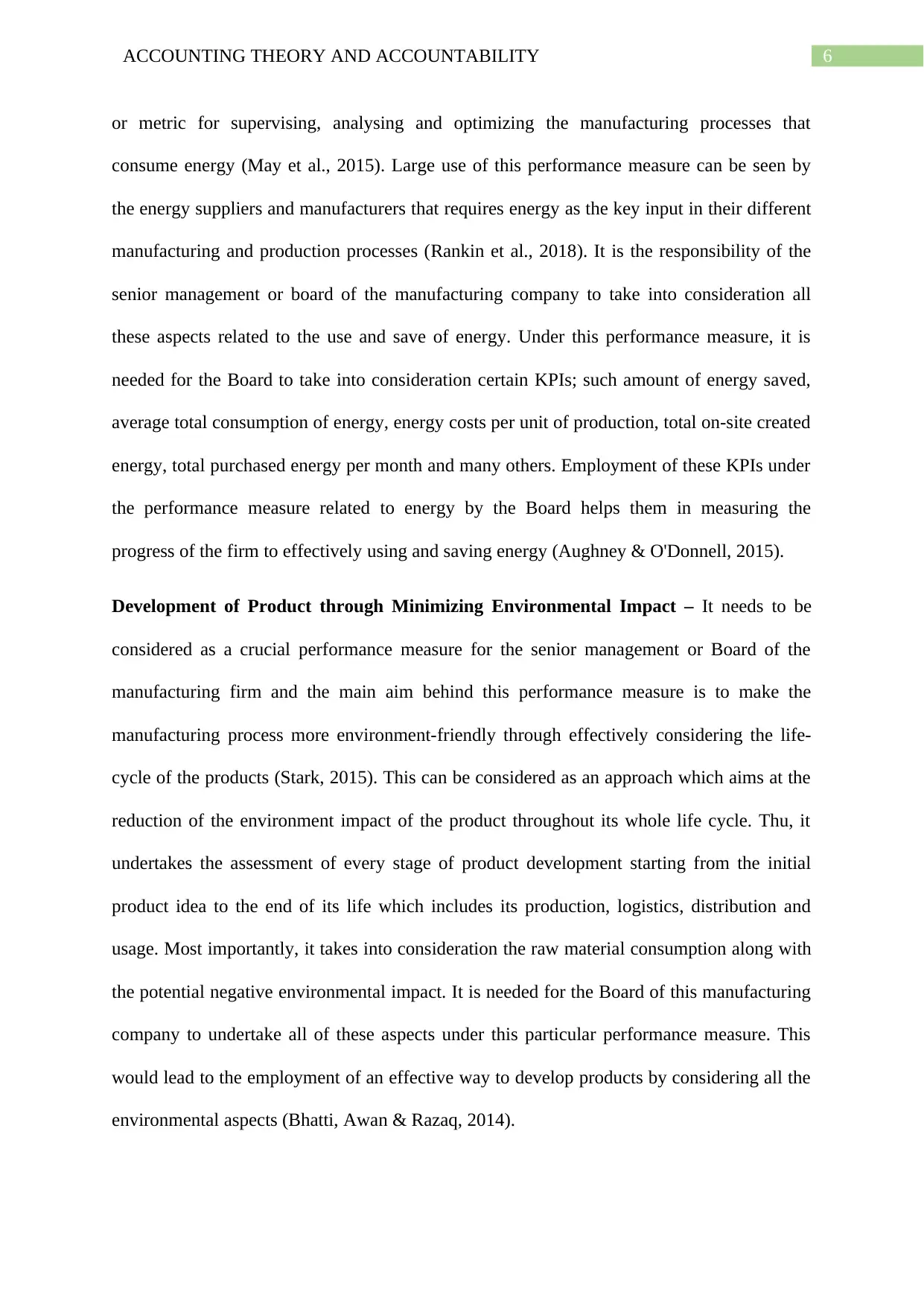
6ACCOUNTING THEORY AND ACCOUNTABILITY
or metric for supervising, analysing and optimizing the manufacturing processes that
consume energy (May et al., 2015). Large use of this performance measure can be seen by
the energy suppliers and manufacturers that requires energy as the key input in their different
manufacturing and production processes (Rankin et al., 2018). It is the responsibility of the
senior management or board of the manufacturing company to take into consideration all
these aspects related to the use and save of energy. Under this performance measure, it is
needed for the Board to take into consideration certain KPIs; such amount of energy saved,
average total consumption of energy, energy costs per unit of production, total on-site created
energy, total purchased energy per month and many others. Employment of these KPIs under
the performance measure related to energy by the Board helps them in measuring the
progress of the firm to effectively using and saving energy (Aughney & O'Donnell, 2015).
Development of Product through Minimizing Environmental Impact – It needs to be
considered as a crucial performance measure for the senior management or Board of the
manufacturing firm and the main aim behind this performance measure is to make the
manufacturing process more environment-friendly through effectively considering the life-
cycle of the products (Stark, 2015). This can be considered as an approach which aims at the
reduction of the environment impact of the product throughout its whole life cycle. Thu, it
undertakes the assessment of every stage of product development starting from the initial
product idea to the end of its life which includes its production, logistics, distribution and
usage. Most importantly, it takes into consideration the raw material consumption along with
the potential negative environmental impact. It is needed for the Board of this manufacturing
company to undertake all of these aspects under this particular performance measure. This
would lead to the employment of an effective way to develop products by considering all the
environmental aspects (Bhatti, Awan & Razaq, 2014).
or metric for supervising, analysing and optimizing the manufacturing processes that
consume energy (May et al., 2015). Large use of this performance measure can be seen by
the energy suppliers and manufacturers that requires energy as the key input in their different
manufacturing and production processes (Rankin et al., 2018). It is the responsibility of the
senior management or board of the manufacturing company to take into consideration all
these aspects related to the use and save of energy. Under this performance measure, it is
needed for the Board to take into consideration certain KPIs; such amount of energy saved,
average total consumption of energy, energy costs per unit of production, total on-site created
energy, total purchased energy per month and many others. Employment of these KPIs under
the performance measure related to energy by the Board helps them in measuring the
progress of the firm to effectively using and saving energy (Aughney & O'Donnell, 2015).
Development of Product through Minimizing Environmental Impact – It needs to be
considered as a crucial performance measure for the senior management or Board of the
manufacturing firm and the main aim behind this performance measure is to make the
manufacturing process more environment-friendly through effectively considering the life-
cycle of the products (Stark, 2015). This can be considered as an approach which aims at the
reduction of the environment impact of the product throughout its whole life cycle. Thu, it
undertakes the assessment of every stage of product development starting from the initial
product idea to the end of its life which includes its production, logistics, distribution and
usage. Most importantly, it takes into consideration the raw material consumption along with
the potential negative environmental impact. It is needed for the Board of this manufacturing
company to undertake all of these aspects under this particular performance measure. This
would lead to the employment of an effective way to develop products by considering all the
environmental aspects (Bhatti, Awan & Razaq, 2014).
Paraphrase This Document
Need a fresh take? Get an instant paraphrase of this document with our AI Paraphraser
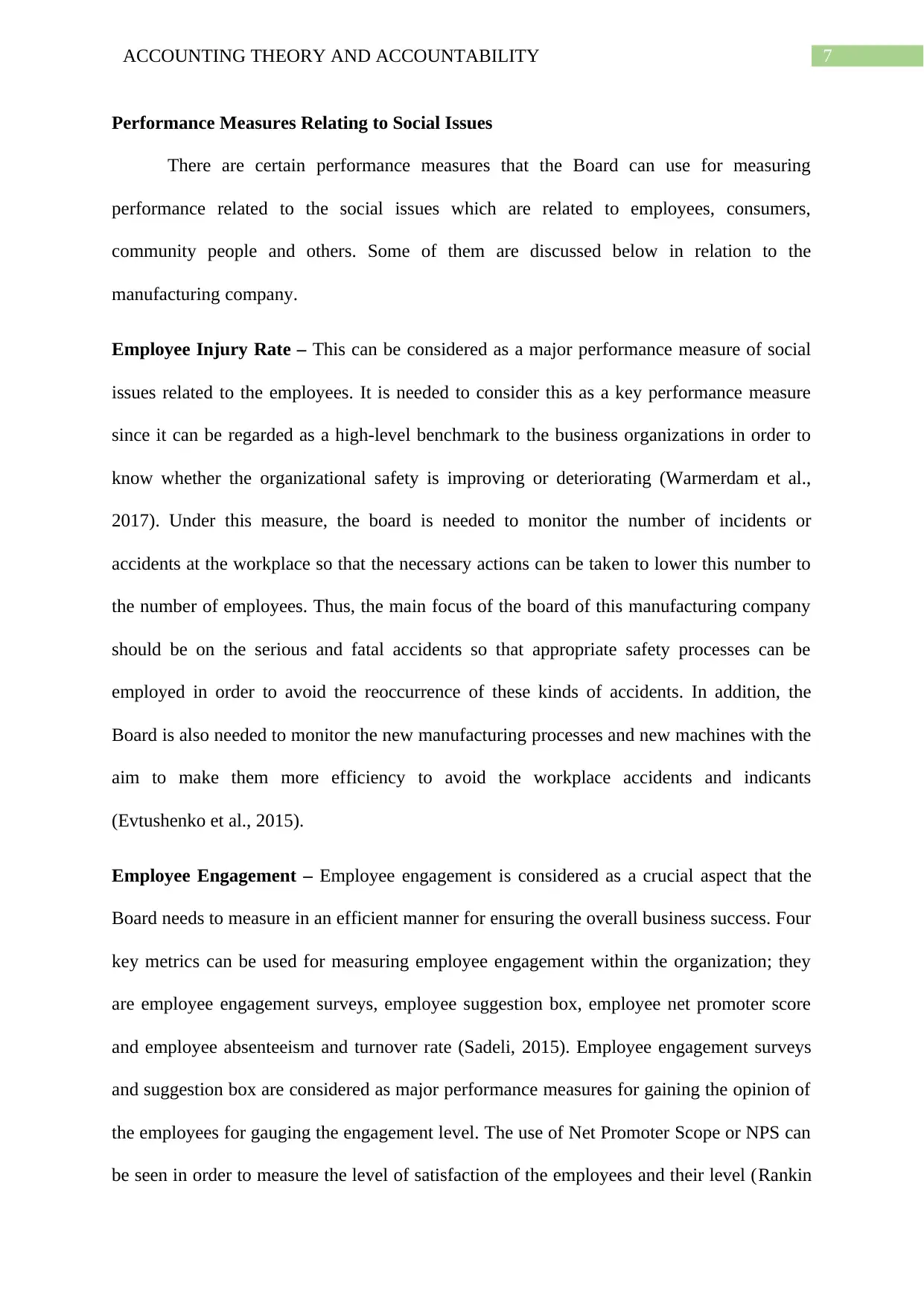
7ACCOUNTING THEORY AND ACCOUNTABILITY
Performance Measures Relating to Social Issues
There are certain performance measures that the Board can use for measuring
performance related to the social issues which are related to employees, consumers,
community people and others. Some of them are discussed below in relation to the
manufacturing company.
Employee Injury Rate – This can be considered as a major performance measure of social
issues related to the employees. It is needed to consider this as a key performance measure
since it can be regarded as a high-level benchmark to the business organizations in order to
know whether the organizational safety is improving or deteriorating (Warmerdam et al.,
2017). Under this measure, the board is needed to monitor the number of incidents or
accidents at the workplace so that the necessary actions can be taken to lower this number to
the number of employees. Thus, the main focus of the board of this manufacturing company
should be on the serious and fatal accidents so that appropriate safety processes can be
employed in order to avoid the reoccurrence of these kinds of accidents. In addition, the
Board is also needed to monitor the new manufacturing processes and new machines with the
aim to make them more efficiency to avoid the workplace accidents and indicants
(Evtushenko et al., 2015).
Employee Engagement – Employee engagement is considered as a crucial aspect that the
Board needs to measure in an efficient manner for ensuring the overall business success. Four
key metrics can be used for measuring employee engagement within the organization; they
are employee engagement surveys, employee suggestion box, employee net promoter score
and employee absenteeism and turnover rate (Sadeli, 2015). Employee engagement surveys
and suggestion box are considered as major performance measures for gaining the opinion of
the employees for gauging the engagement level. The use of Net Promoter Scope or NPS can
be seen in order to measure the level of satisfaction of the employees and their level (Rankin
Performance Measures Relating to Social Issues
There are certain performance measures that the Board can use for measuring
performance related to the social issues which are related to employees, consumers,
community people and others. Some of them are discussed below in relation to the
manufacturing company.
Employee Injury Rate – This can be considered as a major performance measure of social
issues related to the employees. It is needed to consider this as a key performance measure
since it can be regarded as a high-level benchmark to the business organizations in order to
know whether the organizational safety is improving or deteriorating (Warmerdam et al.,
2017). Under this measure, the board is needed to monitor the number of incidents or
accidents at the workplace so that the necessary actions can be taken to lower this number to
the number of employees. Thus, the main focus of the board of this manufacturing company
should be on the serious and fatal accidents so that appropriate safety processes can be
employed in order to avoid the reoccurrence of these kinds of accidents. In addition, the
Board is also needed to monitor the new manufacturing processes and new machines with the
aim to make them more efficiency to avoid the workplace accidents and indicants
(Evtushenko et al., 2015).
Employee Engagement – Employee engagement is considered as a crucial aspect that the
Board needs to measure in an efficient manner for ensuring the overall business success. Four
key metrics can be used for measuring employee engagement within the organization; they
are employee engagement surveys, employee suggestion box, employee net promoter score
and employee absenteeism and turnover rate (Sadeli, 2015). Employee engagement surveys
and suggestion box are considered as major performance measures for gaining the opinion of
the employees for gauging the engagement level. The use of Net Promoter Scope or NPS can
be seen in order to measure the level of satisfaction of the employees and their level (Rankin
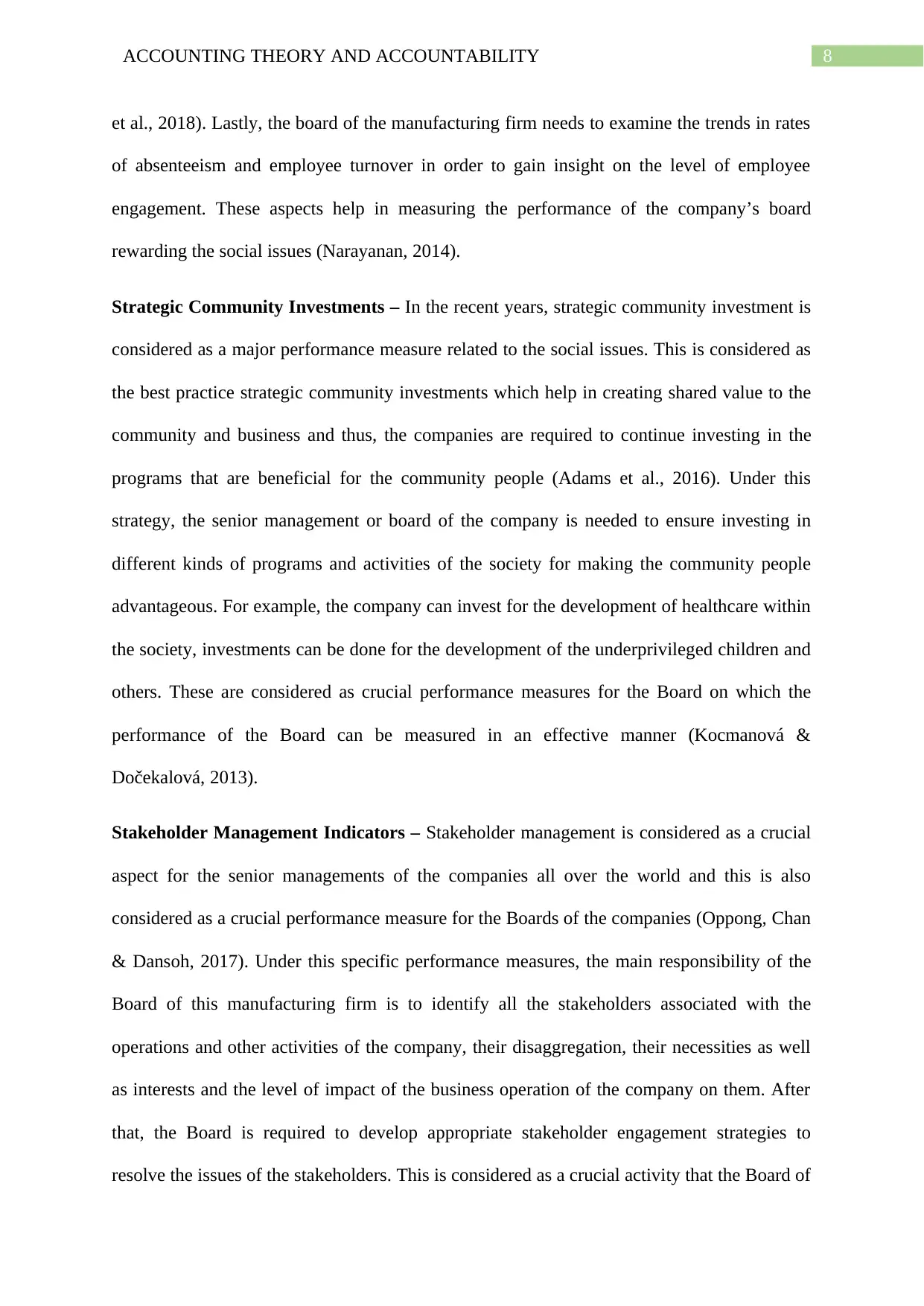
8ACCOUNTING THEORY AND ACCOUNTABILITY
et al., 2018). Lastly, the board of the manufacturing firm needs to examine the trends in rates
of absenteeism and employee turnover in order to gain insight on the level of employee
engagement. These aspects help in measuring the performance of the company’s board
rewarding the social issues (Narayanan, 2014).
Strategic Community Investments – In the recent years, strategic community investment is
considered as a major performance measure related to the social issues. This is considered as
the best practice strategic community investments which help in creating shared value to the
community and business and thus, the companies are required to continue investing in the
programs that are beneficial for the community people (Adams et al., 2016). Under this
strategy, the senior management or board of the company is needed to ensure investing in
different kinds of programs and activities of the society for making the community people
advantageous. For example, the company can invest for the development of healthcare within
the society, investments can be done for the development of the underprivileged children and
others. These are considered as crucial performance measures for the Board on which the
performance of the Board can be measured in an effective manner (Kocmanová &
Dočekalová, 2013).
Stakeholder Management Indicators – Stakeholder management is considered as a crucial
aspect for the senior managements of the companies all over the world and this is also
considered as a crucial performance measure for the Boards of the companies (Oppong, Chan
& Dansoh, 2017). Under this specific performance measures, the main responsibility of the
Board of this manufacturing firm is to identify all the stakeholders associated with the
operations and other activities of the company, their disaggregation, their necessities as well
as interests and the level of impact of the business operation of the company on them. After
that, the Board is required to develop appropriate stakeholder engagement strategies to
resolve the issues of the stakeholders. This is considered as a crucial activity that the Board of
et al., 2018). Lastly, the board of the manufacturing firm needs to examine the trends in rates
of absenteeism and employee turnover in order to gain insight on the level of employee
engagement. These aspects help in measuring the performance of the company’s board
rewarding the social issues (Narayanan, 2014).
Strategic Community Investments – In the recent years, strategic community investment is
considered as a major performance measure related to the social issues. This is considered as
the best practice strategic community investments which help in creating shared value to the
community and business and thus, the companies are required to continue investing in the
programs that are beneficial for the community people (Adams et al., 2016). Under this
strategy, the senior management or board of the company is needed to ensure investing in
different kinds of programs and activities of the society for making the community people
advantageous. For example, the company can invest for the development of healthcare within
the society, investments can be done for the development of the underprivileged children and
others. These are considered as crucial performance measures for the Board on which the
performance of the Board can be measured in an effective manner (Kocmanová &
Dočekalová, 2013).
Stakeholder Management Indicators – Stakeholder management is considered as a crucial
aspect for the senior managements of the companies all over the world and this is also
considered as a crucial performance measure for the Boards of the companies (Oppong, Chan
& Dansoh, 2017). Under this specific performance measures, the main responsibility of the
Board of this manufacturing firm is to identify all the stakeholders associated with the
operations and other activities of the company, their disaggregation, their necessities as well
as interests and the level of impact of the business operation of the company on them. After
that, the Board is required to develop appropriate stakeholder engagement strategies to
resolve the issues of the stakeholders. This is considered as a crucial activity that the Board of
⊘ This is a preview!⊘
Do you want full access?
Subscribe today to unlock all pages.

Trusted by 1+ million students worldwide
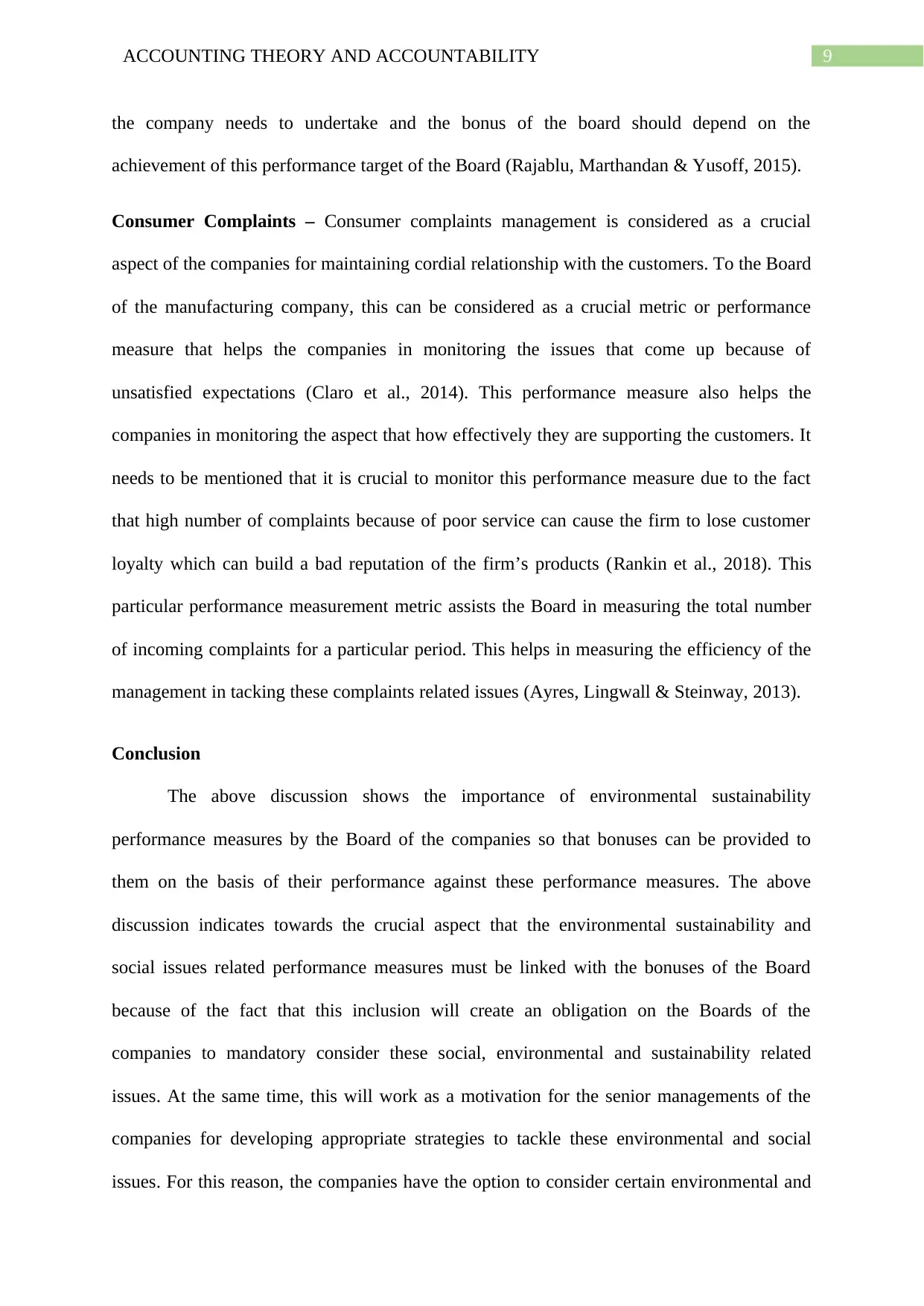
9ACCOUNTING THEORY AND ACCOUNTABILITY
the company needs to undertake and the bonus of the board should depend on the
achievement of this performance target of the Board (Rajablu, Marthandan & Yusoff, 2015).
Consumer Complaints – Consumer complaints management is considered as a crucial
aspect of the companies for maintaining cordial relationship with the customers. To the Board
of the manufacturing company, this can be considered as a crucial metric or performance
measure that helps the companies in monitoring the issues that come up because of
unsatisfied expectations (Claro et al., 2014). This performance measure also helps the
companies in monitoring the aspect that how effectively they are supporting the customers. It
needs to be mentioned that it is crucial to monitor this performance measure due to the fact
that high number of complaints because of poor service can cause the firm to lose customer
loyalty which can build a bad reputation of the firm’s products (Rankin et al., 2018). This
particular performance measurement metric assists the Board in measuring the total number
of incoming complaints for a particular period. This helps in measuring the efficiency of the
management in tacking these complaints related issues (Ayres, Lingwall & Steinway, 2013).
Conclusion
The above discussion shows the importance of environmental sustainability
performance measures by the Board of the companies so that bonuses can be provided to
them on the basis of their performance against these performance measures. The above
discussion indicates towards the crucial aspect that the environmental sustainability and
social issues related performance measures must be linked with the bonuses of the Board
because of the fact that this inclusion will create an obligation on the Boards of the
companies to mandatory consider these social, environmental and sustainability related
issues. At the same time, this will work as a motivation for the senior managements of the
companies for developing appropriate strategies to tackle these environmental and social
issues. For this reason, the companies have the option to consider certain environmental and
the company needs to undertake and the bonus of the board should depend on the
achievement of this performance target of the Board (Rajablu, Marthandan & Yusoff, 2015).
Consumer Complaints – Consumer complaints management is considered as a crucial
aspect of the companies for maintaining cordial relationship with the customers. To the Board
of the manufacturing company, this can be considered as a crucial metric or performance
measure that helps the companies in monitoring the issues that come up because of
unsatisfied expectations (Claro et al., 2014). This performance measure also helps the
companies in monitoring the aspect that how effectively they are supporting the customers. It
needs to be mentioned that it is crucial to monitor this performance measure due to the fact
that high number of complaints because of poor service can cause the firm to lose customer
loyalty which can build a bad reputation of the firm’s products (Rankin et al., 2018). This
particular performance measurement metric assists the Board in measuring the total number
of incoming complaints for a particular period. This helps in measuring the efficiency of the
management in tacking these complaints related issues (Ayres, Lingwall & Steinway, 2013).
Conclusion
The above discussion shows the importance of environmental sustainability
performance measures by the Board of the companies so that bonuses can be provided to
them on the basis of their performance against these performance measures. The above
discussion indicates towards the crucial aspect that the environmental sustainability and
social issues related performance measures must be linked with the bonuses of the Board
because of the fact that this inclusion will create an obligation on the Boards of the
companies to mandatory consider these social, environmental and sustainability related
issues. At the same time, this will work as a motivation for the senior managements of the
companies for developing appropriate strategies to tackle these environmental and social
issues. For this reason, the companies have the option to consider certain environmental and
Paraphrase This Document
Need a fresh take? Get an instant paraphrase of this document with our AI Paraphraser

10ACCOUNTING THEORY AND ACCOUNTABILITY
social performance measures that will focus on the material sustainability, environmental and
social issues. This is beneficial for both the companies and society since these performance
measures would lead to generate shared-value for both the parties.
social performance measures that will focus on the material sustainability, environmental and
social issues. This is beneficial for both the companies and society since these performance
measures would lead to generate shared-value for both the parties.
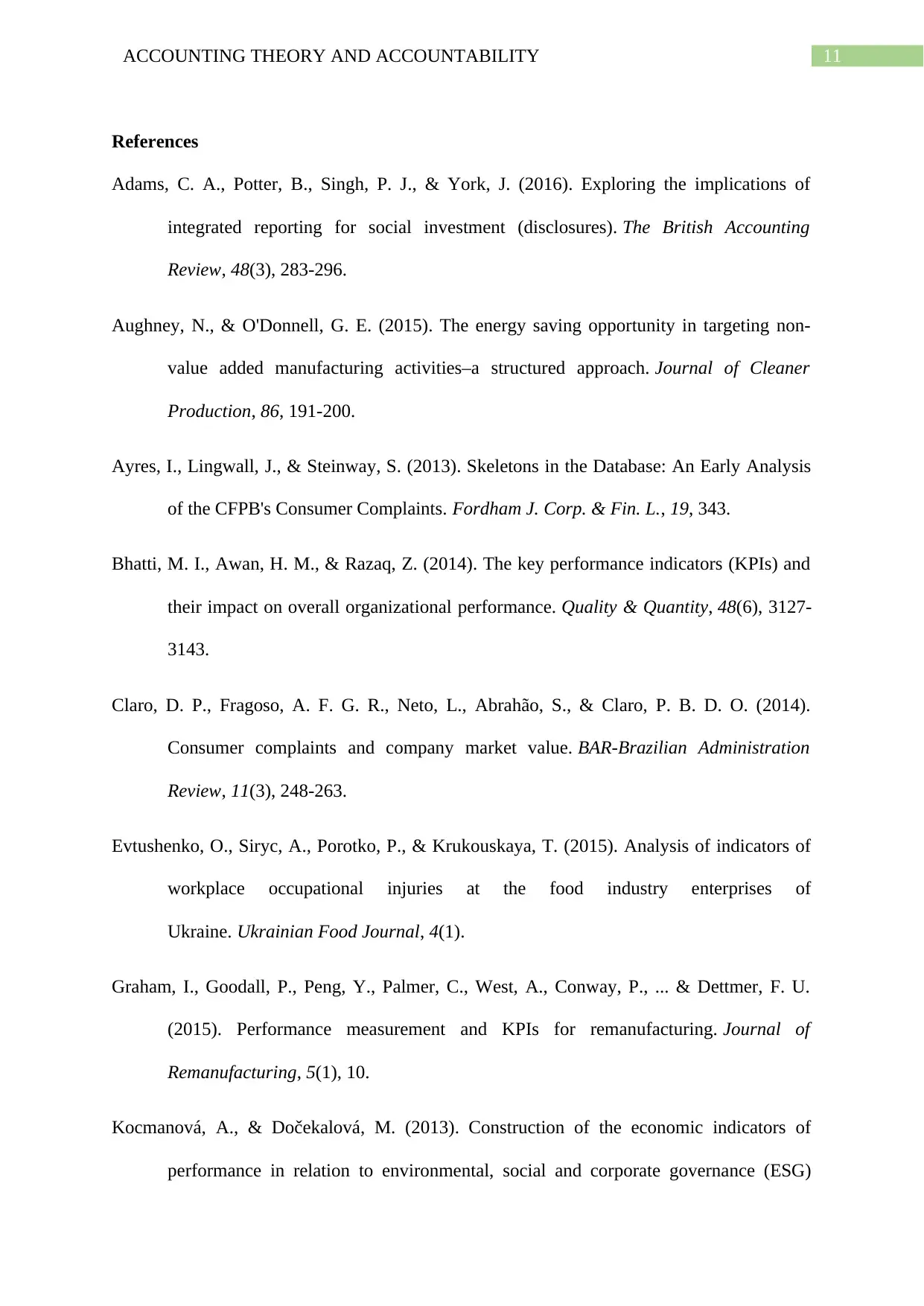
11ACCOUNTING THEORY AND ACCOUNTABILITY
References
Adams, C. A., Potter, B., Singh, P. J., & York, J. (2016). Exploring the implications of
integrated reporting for social investment (disclosures). The British Accounting
Review, 48(3), 283-296.
Aughney, N., & O'Donnell, G. E. (2015). The energy saving opportunity in targeting non-
value added manufacturing activities–a structured approach. Journal of Cleaner
Production, 86, 191-200.
Ayres, I., Lingwall, J., & Steinway, S. (2013). Skeletons in the Database: An Early Analysis
of the CFPB's Consumer Complaints. Fordham J. Corp. & Fin. L., 19, 343.
Bhatti, M. I., Awan, H. M., & Razaq, Z. (2014). The key performance indicators (KPIs) and
their impact on overall organizational performance. Quality & Quantity, 48(6), 3127-
3143.
Claro, D. P., Fragoso, A. F. G. R., Neto, L., Abrahão, S., & Claro, P. B. D. O. (2014).
Consumer complaints and company market value. BAR-Brazilian Administration
Review, 11(3), 248-263.
Evtushenko, O., Siryc, A., Porotko, P., & Krukouskaya, T. (2015). Analysis of indicators of
workplace occupational injuries at the food industry enterprises of
Ukraine. Ukrainian Food Journal, 4(1).
Graham, I., Goodall, P., Peng, Y., Palmer, C., West, A., Conway, P., ... & Dettmer, F. U.
(2015). Performance measurement and KPIs for remanufacturing. Journal of
Remanufacturing, 5(1), 10.
Kocmanová, A., & Dočekalová, M. (2013). Construction of the economic indicators of
performance in relation to environmental, social and corporate governance (ESG)
References
Adams, C. A., Potter, B., Singh, P. J., & York, J. (2016). Exploring the implications of
integrated reporting for social investment (disclosures). The British Accounting
Review, 48(3), 283-296.
Aughney, N., & O'Donnell, G. E. (2015). The energy saving opportunity in targeting non-
value added manufacturing activities–a structured approach. Journal of Cleaner
Production, 86, 191-200.
Ayres, I., Lingwall, J., & Steinway, S. (2013). Skeletons in the Database: An Early Analysis
of the CFPB's Consumer Complaints. Fordham J. Corp. & Fin. L., 19, 343.
Bhatti, M. I., Awan, H. M., & Razaq, Z. (2014). The key performance indicators (KPIs) and
their impact on overall organizational performance. Quality & Quantity, 48(6), 3127-
3143.
Claro, D. P., Fragoso, A. F. G. R., Neto, L., Abrahão, S., & Claro, P. B. D. O. (2014).
Consumer complaints and company market value. BAR-Brazilian Administration
Review, 11(3), 248-263.
Evtushenko, O., Siryc, A., Porotko, P., & Krukouskaya, T. (2015). Analysis of indicators of
workplace occupational injuries at the food industry enterprises of
Ukraine. Ukrainian Food Journal, 4(1).
Graham, I., Goodall, P., Peng, Y., Palmer, C., West, A., Conway, P., ... & Dettmer, F. U.
(2015). Performance measurement and KPIs for remanufacturing. Journal of
Remanufacturing, 5(1), 10.
Kocmanová, A., & Dočekalová, M. (2013). Construction of the economic indicators of
performance in relation to environmental, social and corporate governance (ESG)
⊘ This is a preview!⊘
Do you want full access?
Subscribe today to unlock all pages.

Trusted by 1+ million students worldwide
1 out of 14
Related Documents
Your All-in-One AI-Powered Toolkit for Academic Success.
+13062052269
info@desklib.com
Available 24*7 on WhatsApp / Email
![[object Object]](/_next/static/media/star-bottom.7253800d.svg)
Unlock your academic potential
Copyright © 2020–2025 A2Z Services. All Rights Reserved. Developed and managed by ZUCOL.





